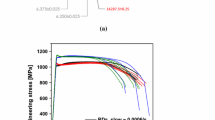Abstract
A cell endowed with the micro-separation characteristics of the material is critical to formulating a predictive tool for nonlinear fracture mechanics analysis. This companion article addresses the second step in a two-step calibration scheme, namely, the calibration of the fracture-process parameters D and f0. The discrete, three-dimensional nature of a cell element enables it to capture important features of (i) interaction between the cell elements forming the fracture process zone and the crack including a single cavity-crack tip interaction and (ii) interaction between the fracture process and the plastic dissipation in the background material. The full three-dimensional computational model is applied to two crack geometries known to give rise to significantly different crack tip constraints and crack growth resistance behavior. Details of the load, displacement and crack growth histories in these specimens including the measured three-dimensional crack profiles are accurately predicted by the computational model. The comparison of model predictions and test data of surface cracked plates loaded by different combinations of tension and bending is reported in the third paper (Gao et al., 1997) in this series.
Similar content being viewed by others
References
Andersson, H. (1977). Analysis of a model for void growth and coalescence ahead of a moving crack tip. Journal of the Mechanics and Physics of Solids 25, 217-233.
ASTM E 1152-87 (1993). Standard Test Method for Determining J- RCurves. In Annual Book of ASTM Standards,American Society for Testing and Materials, Philadelphia.
Becker, R., Needleman, A., Richmond, O. and Tvergaard, V. (1988). Void growth and failure in notched bars. Journal of the Mechanics and Physics of Solids 36, 317-351.
Brown, L.M. and Embury, J.D. (1973). The initiation and growth of voids at second phase particles, in Proceedings of the 3rd International Conference on the Strength of Metals and Alloys, Institute of Metals, London, 164-169.
Faleskog, J. (1994). Crack growth in elastic-plastic materials. PhD thesis, the Royal Institute of Technology, Sweden.
Faleskog, J. and Shih, C.F. (1997). Micromechanics of coalescence - I. Synergistic effects of elasticity, plastic yielding and multi-size-scale voids. Journal of the Mechanics and Physics of Solids 45, 21-50.
Faleskog, J., Gao, X. and Shih, C.F. (1998). Cell model for nonlinear fracture analysis - I. Micromechanics calibration. International Journal of Fracture 89, 355-373.
Gao, X., Faleskog, J., Dodds, Jr., R.H. and Shih, C.F. (1998a). Ductile tearing in part-through cracks - experiments and cell-model predictions. Engineering Fracture Mechanics 59, 761-777.
Gao, X., Faleskog, J. and Shih, C.F. (1998b). Analysis of ductile to cleavage transition in Part-Through Cracks Using a Cell Model Incorporating Statistics. Submitted to Fatigue & Fracture of Engineering Methods & Structures.
Goods, S.H. and Brown, L.M. (1979). The nucleation of cavities by plastic deformation. Acta Metallurgica 27, 1-15.
Gurson, A.L. (1977). Continuum theory of ductile rupture by void nucleation and growth: Part I - yield criteria and flow rules for porous ductile media. Journal of Engineering Materials and Technology 99, 2-15.
Hughes, T.J.R. (1980). Generalization of selective integration procedures to anisotropic and nonlinear media. International Journal for Numerical Methods in Engineering 15, 1413-1418.
Hughes, T.J.R. (1987). The finite element method. Prentice-Hall, Englewood-Cliffs, New Jersey, 232-237.
Koplik, J. and Needleman, A. (1988). Void growth and coalescence in porous plastic solids. International Journal of Solids and Structures 24, 835-853.
Koppenhoefer, K., Gullerud, A., Ruggieri, C., Dodds, Jr., R.H., and Healy, B. (1994). WARP3D: Dynamic nonlinear analysis of solids using a preconditioned conjugate gradient software architecture. Structural Research Series (SRS) 596, UILU-ENG-94-2017, University of Illinois at Urbana-Champaign.
Moran, B. and Shih, C.F. (1987a). Crack tip and associated domain integrals from momentum and energy balance. Engineering Fracture Mechanics 27, 615-642.
Moran, B. and Shih, C.F. (1987b). A general treatment of crack tip contour integrals. International Journal of Fracture 35, 295-310.
Needleman, A., Tvergaard, V. and Hutchinson, J.W. (1992). Void growth in plastic solids, in Topics in Fracture and Fatigue. (Edited by A.S. Argon), Springer Verlag, New York, 145-178.
Shih, C.F. (1981). Relationship between the J-integral and the crack opening displacement for stationary and extending cracks. Journal of the Mechanics and Physics of Solids 29, 305-326.
Shih, C.F. and Xia, L. (1995). Modeling crack growth resistance using computational cells with microstructurallybased length scales, in Constraint Effects in Fracture: Theory and Applications, ASTM STP 1244(Edited by M. Kirk and A. Bakker), American Society for Testing and Materials, Philadelphia, 163-190.
Thompson, A.W. (1987). Modeling of Local Strains in Ductile Fracture. Metallurgical Transactions A 18A, 1877-1886.
Tvergaard, V. (1981). Influence of voids on shear band instabilities under plane strain conditions. International Journal of Fracture 17, 389-407.
Tvergaard, V. (1982). On localization in ductile materials containing spherical voids. International Journal of Fracture 18, 237-252.
Tvergaard, V. (1990). Material failure by void growth to coalescence, in Advances in Applied Mechanics27, (Edited by J.W. Hutchinson and T.Y. Wu), Academic Press, New York, 83-151.
Xia, L. and Shih, C.F. (1995a). Ductile crack growth - I. A numerical study using computational cells with microstructurally-based length scales. Journal of the Mechanics and Physics of Solids 43, 233-259.
Xia, L. and Shih, C.F. (1995b). Ductile crack growth - II. Void nucleation and geometry effects on macroscopic fracture behavior. Journal of the Mechanics and Physics of Solids 43, 1953-1981.
Xia, L. and Shih, C.F. (1996). Ductile crack growth - III. Transition to cleavage fracture incorporating statistics. Journal of the Mechanics and Physics of Solids 44, 603-639.
Xia, L., Shih, C.F. and Hutchinson, J.W. (1995). Computational approach to ductile crack growth under large scale yielding conditions. Journal of the Mechanics and Physics of Solids 43, 389-413.
Author information
Authors and Affiliations
Rights and permissions
About this article
Cite this article
Gao, X., Faleskog, J. & Shih, C.F. Cell model for nonlinear fracture analysis – II. Fracture- process calibration and verification. International Journal of Fracture 89, 375–398 (1998). https://doi.org/10.1023/A:1007410825313
Issue Date:
DOI: https://doi.org/10.1023/A:1007410825313




